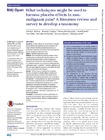What techniques might be used to harness placebo effects in non-malignant pain? A literature review and survey to develop a taxonomy

Abstract
Objectives:
Placebo effects can be clinically meaningful but are seldom fully exploited in clinical practice. This review aimed to facilitate translational research by producing a taxonomy of techniques that could augment placebo analgesia in clinical practice. Design Literature review and survey.
Methods:
We systematically analysed methods which could plausibly be used to elicit placebo effects in 169 clinical and laboratory-based studies involving non-malignant pain, drawn from seven systematic reviews. In a validation exercise, we surveyed 33 leading placebo researchers (mean 12 years’ research experience, SD 9.8), who were asked to comment on and add to the draft taxonomy derived from the literature.
Results: The final taxonomy defines 30 procedures that may contribute to placebo effects in clinical and experimental research, proposes 60 possible clinical applications and classifies procedures into five domains: the patient’s characteristics and belief (5 procedures and 11 clinical applications), the practitioner’s characteristics and beliefs (2 procedures and 4 clinical applications), the healthcare setting (8 procedures and 13 clinical applications), treatment characteristics (8 procedures and 14 clinical applications) and the patient– practitioner interaction (7 procedures and 18 clinical applications). Conclusion The taxonomy provides a preliminary and novel tool with potential to guide translational research aiming to harness placebo effects for patient benefit in practice.
Collections
Date
2017Author
Coghlan, Beverly
Geraghty, Adam WA
Everitt, Hazel
Little, Paul
Seretis, Dionysis
Lewith, George
Holmes, Michelle
Bishop, Felicity L